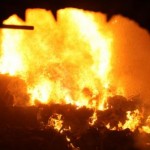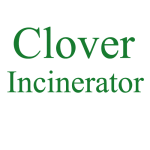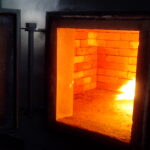Medical Waste Incinerator, 50 to 60 Kg/hr
Item Quantity 5 No.
Support Health Sector Support Project
Point of Installation (Hospitals) Moi Voi, Makindu, Maragua, Eldama Ravine and Isiolo District Hospitals
1. General Description
Supply, delivery, installation and commissioning of a medical waste incinerator suitable for disposal of Medical, General and Pathological waste in a safe and clean environment. The unit shall consist of two chambers and operate on the principal of controlled air and temperature. The unit shall consist a particulate remover (scrubbers) as stipulated in waste management regulations, 2006 (Legal notice NO. 121 of 29th September, 2006). The Unit shall be fully automatic and controlled by an automatic electronic controlled system except loading system which shall be manual. The unit shall be capable of incinerating between 50 to 60 kg of solid medical waste per hour. It shall be constructed from mild or aluminized steel lined with refractory material.
2. Composition
2.1 Main unit
2.2 Accessories
3. Performance specifications
3.1 Main unit
3.1.1 Application For incineration, general and pathological
3.1.2 Capacity 50 – 60 kg/h burn rate
3.1.3
Type Two combustion chambers type; primary and Secondary, controlled/forced combustion air type with a flue gas emission scrubbing unit
3.1.4 Operating time Minimum 8 hours daily
3.1.5 Operating temperature From 850 0C to 1200 0C, Automatic controlled
3.1.6 Residual Ash 5 to 10%
3.2 Primary Chamber
3.2.1
Construction Constructed from heavy duty mild or aluminized steel Or
equal and approved equivalent
3.2.2
Insulation material Refractory material lining similar or equal to calcium
Silicate and hot face combination of heavy duty brickwork
3.2.3
Internal Construction Fixed hearth type complete with gratings, concave bottom
and charging door, lined with refractory material
3.2.4
Charging Door Suitable for manual loading of wastes and with smooth
Dear seal equivalent of Ceramic seals with hinges.
3.2.5 Door Lock Automatic, Electric type
3.2.6
Ash removal door Provided, for removing resultant bottom ash leftovers from the Primary chamber
3.2.7 Gratings Provided
3.2.8 Loading Manual loading of waste
3.2.9
Primary Burner Fully automatic, with fuel, temperature and speed controls with ignition system, flame detector, Air fan complete with safety features, flame failure, Diesel fired fuel injector type and Flange mounted
3.2.10
Blower Provided. For supplying excess combustion air through the distribution system with speed control system
3.2.11 Temperature Minimum exit 850 0C
3.2.12 Observation port To be provided with protective glass type
3.3 Secondary chamber
3.3.1
Construction Constructed from heavy duty mild or aluminized steel or equal and approved equivalent
3.3.2
Insulation Refractory material lining
3.3.3
Combustion Temperatures Above 850 0C, controlled electronically
3.3.4
Gas residue or retention Time > 2 second at minimum 850 0C
3.3.5
Secondary Burner Provided, Diesel fired, fully automatic, with fuel, temperature and speed controls, With ignition system, Flame detector, Air fan, Complete with safety features, flame failure Diesel fired fuel injector type. Flange mounted
3.3.6 Ejector Provided, Venturi type, for cooling the flue gases
3.3.7
Combustion Air Fan Provided for supplying combustion and creating a negative drift and turbulences
3.3.8 Temperature Maximum 1600 0C
3.4 Chimney
3.4.1
Construction Constructed from heavy duty mild or aluminized steel or equal and approved equivalent Refractory material lining
3.4.2 Length 10 m above ground
3.4.3 Bore about 350mm diameter
3.4.5 Discharge temperatures About 850 0C
3.4.6 Emissions To comply with standards in section 9 of third schedule of the waste management regulations, 2006.
3.5 Electrical System
3.3.5
Control unit Fully automatic with microprocessor based control unit (PLC) automating all operations of the incinerator. Capable of monitoring all incinerator parameters With large LCD or similar for display of all progress
Parameters i.e. temperature of primary and secondary chambers, turbulence and time
With status lamp
With user of defined and differed programmed operating cycles for different type of loads/conditions
With safety interlocks, display of errors and visible and audio alarms.
System for continuous emission monitoring
3.5.2
Isolator switch Supply and install isolator switch 240V, 100A for the incinerator unit, including all necessary cables 10m
3.5.3
Distribution Board Supply and install distribution board. 100 A, complete with MCBs suitable for the rating of the incinerator unit and associated equipment. Wiring to be done according IEE regulations.
3.5.4
Wiring Make provisions for wiring the isolator switch, Distribution Board control unit to Incinerator and all associated equipment inside to incinerator room. Working length 20m. Wiring to be done using PVC Sheath cable on steel conduits and trucking and in accordance with IEE regulations
3.6 Fuel System Supply and install storage fuel tank inside the incinerator room at an elevated position (about 1.5 m above the floor)
3.6.1
Fuel Tank Tank capacity, 400 liters, constructed from preferable suitable metallic material or high temperature resistance material
Fuel type Diesel
3.6.2
Fuel Lines Supply and install fuel lines, complete with fuel filters, pump, sight glass, fuel level and all other safety devices and connect from fuel tank to incinerator.
Working length , 20m
Fuel pipe material; Special copper pipes or similar and approved materials
4 Physical characteristics
4.1 Main unit Floor mounted, stand alone, fixed hearth type
Dimensions About 1.2 x 2.2m (WxD)
5 Operating environment
5.1 Power Requirements 240V,A/C 50Hz, single phase, with PE
Ambient temperature 10 0C to 40 0C
Relatively humidity 40% to 90%
6. Accessories
Rack, 2 m long 1 piece
6.1 Waste cart, stainless steel 1 piece
7 Spare parts
7.1 Burner 1 set
7.2 Fuel Filters 6 sets
7.3
All other spare parts required for replacement during and after 12 months of operations. 2 pieces of each
8 Quality Standards
8.2
Manufacturing standards NEMA Kenya Act, 1999
Legal Notice No.121 of 29th September 1999 on waste Management Regulations
EU waste incinerator Directive- EC 76/2000
BS 3316
WHO Emission Standards
World Bank Emission Standards
or any other internationally recognized standards
Conformity to standards CE marked or any other internationally recognized documents
9 Local back up service
9.1 Available Should be available locally
9.2 Capacity to service equipment Manufacturer/Agent shall have adequate facilities, spare parts, qualified and skilled technical staff to offer comprehensive maintenance service and spare parts sales for the lifespan of the incinerator
10 Delivery point
10.1 KEMSA For inspection and verification
10.2
Moi Voi, Makindu
Maragua, Eldama Ravine and Isiolo Hospitals For installation, testing, NEMA Certification and commissioning
11 Pre installation works
Provide for foundation plinth, necessary plumbing works, Fuel piping works, Elevated Diesel oil storage tank, electrical works including cabling, trunking and switch gears required to install the incinerator and all its accessories to required IEE standards
12 Installation and testing Complete installation and set up of the incinerator at designated as per manufacturer’s instructions
Provide fuel and test run the incinerator for 3 hours daily for 7 days
13 Training
13.1
User training On site user training on operation and daily up keep
13.2
Maintenance training On-site maintenance training on Preventive Maintenance, repair and trouble shooting
14 Technical Documentations
14.1 User manuals 2 sets
14.2 Service manuals 2 sets
14.3 Drawings 2 sets
15 Commissioning
15.1 Testing and Commissioning of the machine to the satisfaction of the user
16 Warranty
16.1 Equipment Minimum of one year after commissioning on all parts.
16.2 Equipment system Nil
17. Maintenance contract
17.2 Comprehensive preventive & repair service Provided a 12 months comprehensive preventive and repair service contract inclusive of spare parts and material from date of commissioning
Author Archives: incinerators
How to Buy Incinerator
1. Clover Medical save all rights to mend/update product information on website. The specifications are subject to change without prior notice.
2. We accept business term: FOB/C&F/CIF term, by sea/train, full container or bulk goods. 1. FOB (Free on Board), the price leave China port. 2. C&F (Cost and Freight), FOB price and freight cost. 3. CIF (Cost and Insurance and Freight), FOB price and insurance fee and freight cost.
3. Payment Term:
By sea: 50% deposit T/T (bank transfer) in advance, and 50% balance T/T before shipping day.
By Train: 100% T/T in advance.
4.Shipping Document & Packing: Generally, We supply (1)Bill of Lading (Way Bill), (2)Commercial Invoice, (3)Packing List ONLY.
If any further documents/certification and label print/words on packing material or documents which request by importer or local customs, whatever happen in China or oversea, should inform seller in advance and charge as actual cost. For example, Fumigation Certification, embassy certificate, BV/SGS…inspection, certificate of original (C/O), Form A, etc. Buyer must to inform seller in advance and pay these cost. Seller save all rights to postpone/cancel shipping and request lost cost cause this incident. If the importer local customs arrest/request penalty or other situation caused by buyer mistake, Clover Medical save all right to request compensation/litigation. Thanks for your cooperation.
5. The leading time is mostly 3-6 weeks, depending on the products and quantity.
7. Guarantee: One year for the equipment. We supply spare parts for maintenance, free charge within the first year and the delivery charge is on the buyer.
8. Insurance: Bear all risks of loss of or damage to the goods from the time they have passed the ship’s rail at the named port of shipment. we proposal apply All Risks insurance under each contract. When buyer pickup goods at local site, must inspect carefully. If any damage happened under insurance policy, buyer should inform insurance company and Clover Medical Limited immediately. We will provide necessary assistance.
containerised high temp incinerator
Waste Incinerators International Market Analytics
Key Word:
small incinerators
medical waste incinerator
pet animal cremation incinerator
incinerator manufacturers
Incinerator is a incineration equipment, direct fire waste by gas fuel or oi fuel. As different circumscription, incinerator can be named many words as below:
Treatment capacity: small scale incinerator, large scale incinerator and incineration pant.
Waste material: Municipal waste incinerator, medical waste incinerator, animal cremation incinerator, human cremators
Incinerator fuel: gas incinerator, oil incinerator
Waste to Energy (WTE): WTE incinerator, non-WTE incinerator
Incinerator Manufacturer: China incinerator manufacturer, UK incinerator manufacturer, USA incinerator manufacturer, India incinerator manufacturer.
Famous Incinerator manufacturer company: Inciner8(UK), Clover Incinerator(China), Pennram (USA) , Haat (India)
Burning Rate: 5kgs/hour, 10 kgs/hour, 15 kgs/hour, 20 kgs/hour, 30 kgs/hour, 50 kgs/hour, 100 kgs/hour, 150 kgs/hour, 300 kgs/hour, 500 kgs/hour
Pyrolytic incineration technical is traditional waste treatment way for many years. All over the world, in many countries, people anti incinerator because the incinerator will produce a large Dioxin in the smoke. “Dioxins” refers to a group of toxic chemical compounds that share certain chemical structures and biological characteristics. Dioxins can be released into the environment through forest fires, backyard burning of trash, certain industrial activities, and residue from past commercial burning of waste. Dioxins break down very slowly and past releases of dioxins from both man-made and natural sources still exist in the environment. Anyhow, we have to remind that, this is large scale incineration pant, generally more than 30 ton per day. This is a social problem, to analyze and suggest ways in different angles from the public, government, economic development, environmental protection, technology development, etc.
So, why we still use incinerator?
First, for the medical waste from hospital, the pyrolytic incinerators is best treatment up to now. Pyrolytic technology can kill the virus, pollution control.
Second, for human body, pet animal, in many countries and regions, we desire to cremation them. This is the ceremony in the process of society development, and ceremonies to commemorate the disappearance of life.
As above two reason but not only above, we still use incinerators.
How you can find reasonable incinerator for your local site?
Incinerator is not a cheap equipment, generally the small scale model’s price around $5,000usd per unit and large scale model’s price more than $50,000usd per unit. So, before purchase one unit incinerator, you have to make clear following items:
A, burn what? Incinerator is a incineration equipment, function is fire waste. So what kind of waste you want to treatment?
B, small or large? This according to the waste output every day or the waste volume per feed time, like animal size.
C, fuel? Incinerator use oil or gas fuel, generally, gas fuel is cheaper than oil and the smoke cleaner than oil fuel model. But some local site don’t have gas supply system.
And other technology items, like power(220v, 380v), waste feed door type, incinerator structure, etc.
After you clarify these, you can go to find a local or international manufacturers, asking prices, technical specifications and ultimately purchasing the right products.
Clover Incinerator
Nanjing Clover Medical Technology Co., Ltd. is a leading waste incinerator manufacturer in China. All series included burning capacity 10kgs per hour, 30kgs per hour,50kgs per hour,100kgs per hour,150kgs per hour,300kgs per hour,500kgs per hour. Up to now, all models sale to all over the world and have good feedback from end-customer. The YD Model medical incinerator have multi-combustion chamber and basic dry scrubber (smoke filter chamber) with reasonable project budget. For the cleaner emission require, we accept custom made wet scrubber for incinerator and this will be also our next working by focusing on emission technical.
Regular model incinerator for market with burning rate from 10kgs to 500kgs per hour and we always proposal customer send us their require details, like waste material, local site fuel and power supply, incinerator operation time, etc, so we can proposal right model or custom made with different structure or dimensions.
Incinerator Model YD-100 is a middle scale incineration machine for many different usage: for a middle hospital sickbed below 500 units, for all small or big size family pets (like Alaskan Malamute Dog), for community Municipal Solid Waste Incineration, etc. The primary combustion chamber volume is 1200Liters (1.2m3) and use diesel oil or natural gas fuel burner original from Italy.
All our incinerator use stainless steel chimney, not steel.All our incinerator have two combustion chamber at least, not single chamber. All fuel burner from Italy made with famous brand, best quality.
300kgs per hour burning rate incinerator is well liked by market because this model can be medical waste incineration equipment for big hospital and also very good for other solid waste treatment with lowest cost, even if big size animals also can be feed into the combustion chamber. The primary combustion chamber volume is 2.4m3, big enough for common size animals. For shipping transport, YD-300 can be loaded into 40’feet full high container.
Big size combustion chamber up to 4.0m3 and Internal Dimensions is 257 x 147 x 108cm with feeding door opening 108 x 128cm. This model can be a small waste incineration factory with little amount of budget funds. If end customer use this for farm to burn animals like cow, horse or camel, contact with us now.
Smart Ash Incinerators
Smart Ash Incinerators
1. Size requirement for the incinerators is that the unit works with a 55 gallon open ended
steel drum.
2. The unit should operate wit. no fuel and use only 120V or 220V electricity for the blowers.
3. The unit should be capable of burning oil contaminated wastes and medical wastes with a moisture content of 0-15%J
4. Each unit should come witH two steel drums, so that a spare drum is available.
Spare Parts Option
If there are any vendor suggested spare parts , that list and price should be included as an option in the offer.
INDUSTRIAL INCINERATORS
Large incinerators – INDUSTRIAL INCINERATORS – specs below.
2.) Size requirement for the incinerators is 750 — 850 kg capacity
3.) The bum rate should be 80 LL 100 kg/ hour.
4) The primary chamber shouId have an operating temperature of 900 -1200 degree C.
5) The incinerator should hate a high temperature secondary chamber and 2 second gas
retention time at 850- 1150 degree C so that it is suitable for high risk materials.
6). The incinerator should have temperature monitoring and thermostat control for ease of
operation and assurance of bum temperature to confirm correct operation.
7). The incinerator should be capable of burning any of the hazardous wastes listed in the
subsequent section.
8) The incinerator should be capable of burning diesel oil and should include a larger fuel
tank (10-500 litres) and generator (3 –40 kV) set that can be carried on the trailer with the
incinerator so that the unit requires no external electrical power supply.
9.) The incinerator should be trailer mounted so that it is a po
Hazardous Waste to be Incinerated
Hazardous solid chemical:
Different types of combustible solids, used textiles, grease, and toner cartridges, chemicals
for water purification and photographic consumables and plastic material, empty
plastic/metal cans that still contain remnant hazardous material, oil absorbent.
Hazardous liquid chemical:
Mainly different types. of Acid, Paint, Varnish, Acetone, White Spirit Aromatic-less
Solvents, Synthetic Liquid for Break Systems, Aircraft De-icing Liquid, Hydraulic and
Compressor oil, Freon, used in some older refrigeration units, Insecticide liquid/spray, air
refresh spray and other similar chemicals.
Contaminated fuel:
Mainly diesel or gasoline contaminated by water or solvents.
Used and/or Contaminated oil:
Used motor oils and/or mineral oils unfit for their originally intended use. Mainly motor
and gearbox oil (approximately 80%) contaminated by a mixture of white spirit and acetone (approximately 51%), hydraulic liquid (approximately 5%).
Contaminated water:
Waste oilshvater, leaches, hydrocarbons/water mixtures, emulsions and leachate.
Contaminated soil:
Soil polluted by oil, fuel or 11 chemicals.
Contaminated soil polluted by chemicals that has to be recycled in landfill.
Contaminated soil—treated and replaced on site.
Oil Contaminated Solids
Rags, Absorbents, Cardboard, oil and fuel filters, air filters are not consider as hazardous materials.
Electronic waste:
Waste electrical or electronic appliances or assemblies, including printed circuit boards,
containing toxic material and/or heavy metal and/or emitting low radiation.
Used battery cells:
Dry battery, UPS battery or other types, unsorted waste batteries/ battery cells, containing
materials that are hazardouy.
Used lead-acid batteries:
Waste lead-acid batteries, rained/un-drained, and whole or crushed.
Hazardous medical waste:
Clinical and related waste, arising from medical, nursing or similar practices and waste
generated in clinics during the investigation or treatment of patients (bio hazard).
Expired drugs, solid:
Waste pharmaceuticals, drugs and medicines, including sensitive medicines.
Expired drugs Iiquid:
Waste liquid pharmaceuticals, different type liquid chemicals for treatment, medical
grease, and paraffin based xpired medicines.
Expired and/or contaminated fod:
Spoiled fresh food or unusable MRE’s (Meal Ready for Eat – dry food)
Onsite Training and Assem Option for Industrial Incinerators
I. The bidders should includ 1a price in their offer for training in a central location ( Goma or
Bukavu) approximately 15 staff in the operation and maintenance of the
equipment.
Incinerator Introduction
Principle of the Incinerator equipment is incineration/combustion/burn. Generally, the function is waste treatment for Solid waste, Liquid waste, Gas waste, etc.
The main body is one combustion chamber (at least), Refractory line or firebrick, Insulation materials and the outer plate. Ignition element is external oil or gas burner. The burner can be running until waste burnout but for some waste like plastic, paper (sometime, mix coal with waste before feeding), they can combustion itself after Ignition. During combustion, burner has a fan itself for Oxygen supply and also protect burner avoid heat damage from combustion chamber. And, there a external fan blow air into combustion chamber. The Exhaust gas blow out after combustion.
Considering Environmental Protection requirements and rules, almost all incinerator have secondary combustion chamber (after-burn, post-combustion), even if third combustion chamber. The secondary burner burn the Exhaust gas from primary combustion chamber, this technology make sure sufficient combustion, few black smoke and smell.
The updated incinerator technology focus on Exhaust gas treatment to remove Hazardous material and other function from incinerator, like heat recovery (waste to energy), save fuel cost, PLC Automation operation.
In some Developed countries, some new waste treatment method like High-temperature cooking, waste carbonization, crushing sterilization technology is instead of incineration technology.



